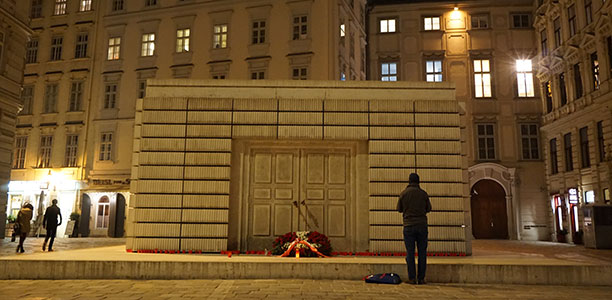Jewish Vienna

There are innumerable anecdotes and stories surrounding Vienna’s Jewish community. Just one example, why does a “talking fish” decorate the entrance to Döbling cemetery? Legend has it that an observant Jew once brought a live fish home for passover. Just as his wife wanted to cut the fish’s head off it began to speak. A rabbi was consulted who declared that the fish must once have been a very pious jew, and so it was not permissible to eat the fish under any circumstances. Instead of landing on the holiday table, a monument was built to the “talking fish”.
There are many reminders of Jewish life in Austria, and especially in Vienna. The contribution of the city’s Jews to music, literature, visual arts, and theater at the end of the nineteenth century and in the early decades of the twentieth was immense. The idea of establishing the Secession art association, and constructing its magnificent art nouveau gallery, was born in Berta Zuckerkandl’s salon. Composers such as Gustav Mahler, Arnold Schönberg, and Alexander Zelimsky were leading figures in Vienna’s musical life. The list of Viennese writers and journalists of Jewish origin is long and distinguished, and accounts for a major part of twentieth-century Austrian literature. Arthur Schnitzler, Peter Altenberg, Karl Kraus, Franz Werfel, Stefan Zweig, Franz Kafka, Friedrich Torberg, Hans Weigel, Elias Canetti, Jura Soyfer, Hilde Spiel – each name stands for a specific chapter in Austrian literary history. The reputation of the Vienna school of medicine is due in large measure to the work of Jewish doctors: Emil Zuckerkandl, Viktor E. Frankl, Otto Loewi and Robert Bárány are just a few of the leading names in the field of science.
A look back into history: the existence of a Jewish settlement in Vienna around what is today the Judenplatz can be documented as early as the thirteenth century. At that time Jews were still permitted to settle unhindered in Vienna. This was not to last for long however, and the first expulsion of Vienna’s Jews took place around 1420. A sad reminder of the event is a bas-relief on the house “Zum grossen Jordan” at Judenplatz 2, which recalls Jörg Jordan, the first Christian owner of the building following the pogrom.
This age of irrational hatred was followed by a more tolerant period under Emperor Rudolph II, which was ended in turn by an escalation of anti-Semitism at the beginning of the seventeenth century. In 1624 Emperor Ferdinand II proclaimed that Jews had to live outside the city walls on an island in the Danube just opposite the town. This Jewish town in the “Unterer Werd” (today Vienna’s second district) was bordered by what is today the Taborstrasse, the Augarten park, the Grosse Schiffahrtsgasse, the Krummbaumgasse, and the Carmelite monastery. About fifty years later all Jews were expelled from Vienna by imperial decree, and the great synagogue was turned into the Church of St. Leopold.
In spite of anti-Semitism, Vienna’s Jewish community grew to number 183,000, and was Europe’s wealthiest in 1938 when Austria was annexed by Nazi Germany. The city’s second district was also traditionally a Jewish neighborhood until that fateful year. Only about 2,000 Jews survived the deportations and concentration camps of the Holocaust. Waves of emigration from eastern Europe, and particularly from the former Soviet Union, brought an influx of new arrivals. The Jewish population of Vienna today can only be estimated: Of the 12,000 Jews who are thought to live in the city just about two-thirds are officially members of the community.
Today there is not much visible evidence of Jewish life, though on Friday evenings orthodox Jewish families can be seen making their way on foot to the main synagogue in the Seitenstettengasse in the first district. The exterior of the building, constructed between 1824 and 1826 by the Biedermeier architect Josef Kornhäusl, is unremarkable. To comply with the regulations of the time concerning Jewish houses of worship, the synagogue was built as part of an apartment house, which saved it from destruction during Kristallnacht in November 1938. Today the synagogue is guarded by policemen around the clock, but is open to visitors upon presentation of ID.
by Roman Grinberg, artistic director of the Vienna Jewish Choir
www.wjchor.at
